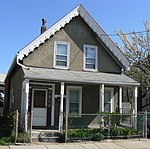Amelia Earhart Dam
Dam stubsDams completed in 1966Dams in MassachusettsEarth-filled damsEverett, Massachusetts ... and 7 more
Locks of the United StatesMassachusetts building and structure stubsMonuments and memorials to Amelia EarhartMystic RiverSomerville, MassachusettsTransportation buildings and structures in MassachusettsTransportation buildings and structures in Middlesex County, Massachusetts

The Amelia Earhart Dam is an earth-fill dam spanning the Mystic River near its mouth between Somerville and Everett, Massachusetts. It was built in 1966 to regulate tidal effects and the incursion of salt water in the upstream river basin. It has 3 locks for marine traffic. The largest is 325 feet long, and 45 feet wide; the two smaller locks are 120 feet long and, 22 feet wide. There is no public access to the dam. The dam is named after the aviation pioneer Amelia Earhart whose plane disappeared in 1937. Earhart lived in nearby Medford, Massachusetts in the 1920s.
Excerpt from the Wikipedia article Amelia Earhart Dam (License: CC BY-SA 3.0, Authors, Images).Amelia Earhart Dam
Mystic Avenue, Somerville
Geographical coordinates (GPS) Address Nearby Places Show on map
Geographical coordinates (GPS)
| Latitude | Longitude |
|---|---|
| N 42.394881 ° | E -71.075054 ° |
Address
Mystic Avenue
02145 Somerville
Massachusetts, United States
Open on Google Maps








